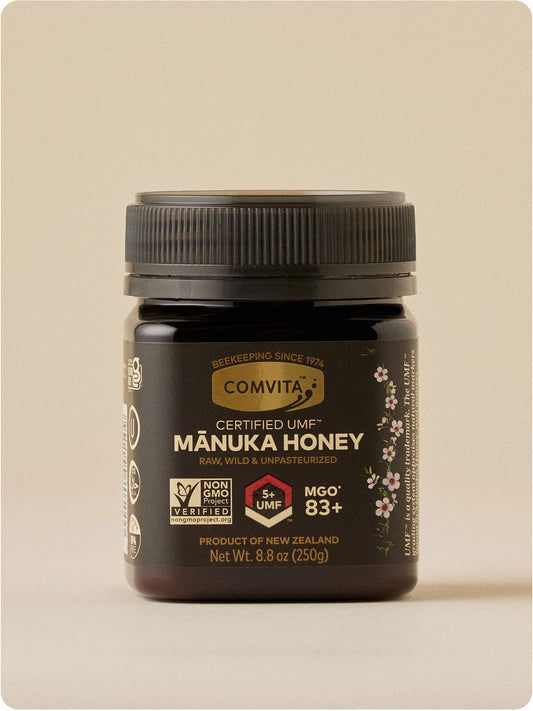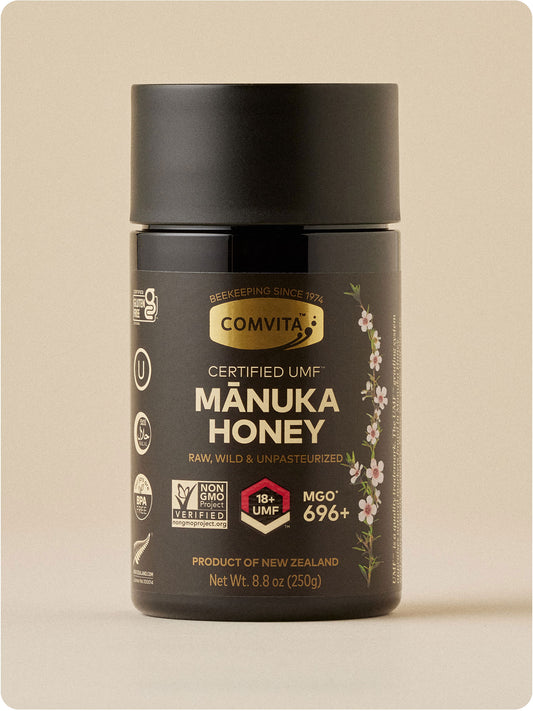
The Manuka Flower - Everything You Need to Know
We all know honey comes from bees, who collect nectar and pollen from flowers. Manuka Honey is only made from one type of flower –– Manuka, which is prevalent in the countryside of New Zealand. Without the Manuka flower, we wouldn’t have Manuka Honey.
Manuka is a prolific shrub-type tree, native to New Zealand, and is often one of the first species to regenerate on cleared land. It is typically a shrub growing to 7–16 ft tall, but can grow into a moderately sized tree, up 49 ft or so in height. It is evergreen, with dense branching and small leaves, and the flowers are white, occasionally pink. The wood is tough and hard. The flowers from which bees collect nectar and pollen are extremely special because they contain properties not found in any other flower. The plant is resilient and can grow in extreme weathers/climates, however the flowering period is super short –– just 2-6 weeks per year in the summer (December-January in the Southern Hemisphere).
What is it about this flower that makes honey with properties unlike any other? Here are 9 fascinating facts about the Manuka flower, how it produces the world’s most beneficial honey and the carefully orchestrated steps we at Comvita take to ensure a healthy, sustainable harvest:
Manuka flower benefits
The astonishing manuka flower has many health benefits. The active constituents within this evergreen shrub, manuka are high in volatile oils, tannis, flavonoids and triterpenes. This incredible chemical makeup has been found to be antibacterial, anti fungal, anti microbial, and anti inflammatory.
9 fascinating facts about the Manuka flower
1. The Mānuka Flower Gives Manuka Honey Its Unique Healing Properties
In studies, Manuka Honey has been shown to have antimicrobial properties - which is why hospitals and wound care clinics have long used it for healing. It also has natural anti-inflammatory, antioxidant and immune-modulatory properties. Together these qualities make Manuka Honey great support for digestion, immune function and skin care. But where does all that come from? What makes Manuka Honey such a powerful wellness solution is all born from the nectar of the Manuka flower. There are three phytochemical markers unique to Manuka Honey: Methylglyoxal (also known as MGO, and a key compound responsible for Manuka’s antimicrobial properties), Dihydroxyacetone (or DHA, which is the origin source of MGO and converts to MGO over time), and Leptosperin (a plant compound found only in Manuka that may possess anti-inflammatory properties). In all, Manuka Honey contains over 2,000 individual natural compounds, which is 20x more than some conventional honey varieties (even local specialty honeys).
2. The Manuka Flower Only Blooms 2-6 Weeks Of The Entire Year
During a 2-6 week period, peaking in mid-December (the start of Summer down in New Zealand), Manuka is in bloom. Individual flowers may only be open for 5 days –– making a very short window for bees to collect nectar from the flower.
3. Mānuka Is Extremely Delicate
Though the Manuka bush itself is resilient, Manuka flowers are extremely delicate and susceptible to even slight variations in climate, rainfall and wind. Weather extremes also keep bees from harvesting in the very small bloom window. Moreover, development (urban and agricultural) has pushed the once abundant Manuka bush into the most remote, inaccessible parts of the country. This may be a good thing for the survival of the plant and the quality of Manuka Honey - being far away from pesticides, herbicides and other human contact keeps the Manuka flower, bee colonies and Manuka Honey healthy and GMO-free.
4. Bees Take 22,700 Trips To The Manuka Flower To Create A Jar Of Manuka Honey
In addition to the rarity of the bloom, and the hard-to-get-to places where Manuka bushes grow naturally, it also takes bees around 22,700 individual trips to the Manuka Flowers to collect enough nectar to create one 17.6 oz (500g) jar of Manuka Honey. One bee may only collect enough nectar to make ⅕ teaspoon of honey in their lifespan, and one hive may have 40,000 bees collecting nectar to convert into honey. Between the bees, the beekeepers, researchers, testers, packers, and more, there’s a lot of work and livelihood that goes into every jar you see on the shelf, which is why each jar is a precious gift to be honored.
5. Monofloral Manuka Honey Possesses The Most Benefit
Certified UMF™ Manuka Honey is ‘monofloral,’ created from the nectar of the Manuka flower. No one can tell bees where to go or which flowers to visit, but certain measures can be taken in where and when hives are introduced to encourage bees to harvest from the Manuka flower. Without those measures, bees will pollinate a variety of flowers in addition to the Manuka flower, which creates ‘multifloral’ Manuka Honey. Multifloral Manuka contains lower levels of Manuka’s active compounds (usually not measuring high enough to get a rating from UMF™ for its ‘Unique Manuka Factor’). All Comvita UMF™ Manuka Honey is monofloral.
6. Flowers “Hear” Bees & Sweeten Their Nectar
A new study from Israel has shown that flowers are competitive. They are able to sense the vibration of bees’ wings and respond by temporarily sweetening their nectar to attract pollinators. Able to tune out other ‘noise’ such as wind, flowers have developed this evolutionary advantage to continue their genetic legacy. Like other flowers, Manuka may be “listening” out for the bees they depend on.
Source: National Geographic
7. Manuka Bushes Restore Unhealthy Soil & Protect Waterways
Throughout New Zealand, regenerative agriculture programs (including areas planted by Comvita) have prioritized planting Manuka bushes in damaged or depleted land areas. For farmers, planting Manuka trees helps maintain the soil. Near waterways, the Manuka bush also helps prevent erosion, in one study, 65% fewer storm-related landslides occurred over a 10-year period. Up and down New Zealand, Comvita has planted over 6 Million Manuka trees since 2016, enhancing biodiversity and restoring. It’s all in the name of creating more pesticide-free, GMO-free, wild and untouched spaces for both plants and bees to thrive.
Source: www.plantandfood.co.nz
8. Timing Is EVERYTHING In Manuka Honey
Comvita's 48 years of beekeeping expertise and continuation of the craft means we have to plan everything really carefully year round to ensure a successful harvest. Our bees must be carefully nurtured throughout the year so they are at full health at just the right time, then bee hives must then be carefully placed in the most remote regions of New Zealand (without stressing out the hive) JUST as the blossoms are opening. If bees arrive too soon, they’ll visit other flowers. If it gets too windy or rainy, the bees will stay inside the hive and eat their own honey. Creating the highest quality Manuka Honey takes scientific precision, harmony with nature, and, for Comvita, over 48 years of expert beekeeping and cultivating good instincts for quality.
9. Manuka Creates Prosperity
It’s not just about healing people, land or waterways, the popularity of Manuka has also helped develop green infrastructures in New Zealand. New generations are learning regenerative land use practices, how to help native biodiversity prosper, and the traditional craft of beekeeping (which Comvita has been doing since 1974). Our co-founder Claude Stratford was a beekeeper for 90 years of his 102 year life, and he attributed much of his vitality to the benefits of his daily dose of Manuka Honey. For as much as Manuka has helped restore and regenerate the Earth, it has also given a path to prosperity that benefits the body, the greater good and generations to come.
This rarest of flowers is the reason for one of nature’s most precious wellness resources, Manuka Honey. Think of all the extraordinary things that had to happen at just the right time in just the right place to create the conditions for Manuka Honey - just like all the extraordinary things that had to occur for an ordinary day in your life to be possible.
FAQs
When does manuka flower?
The Manuka Flower only blooms 2-6 Weeks of the entire year during a 2-6 week period, peaking in mid-December (the start of Summer down in New Zealand), Manuka is in bloom.
What flower does manuka honey come from?
Manuka honey comes from bees that pollinate Leptospermum scoparium, or the manuka bush, which grows predominantly in New Zealand and also in Australia. Other species of this bush grow all over the world, but do not produce the flowers bees need in order to produce manuka honey.
Is Manuka flower only in New Zealand?
Manuka, or Leptospermum scoparium, is a scrub-type tree which grows prolifically around coastal areas of New Zealand.






